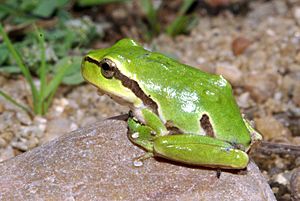Moller's tree frog facts for kids
Quick facts for kids Moller's tree frog |
|
|---|---|
 |
|
| Scientific classification | |
 |
|
| Synonyms | |
|
The Iberian tree frog or Moller's tree frog (Hyla molleri) is a small frog that lives in Europe. You can find these frogs in Spain, Portugal, and parts of France. They are known for their amazing ability to climb trees and bushes.
Contents
About the Iberian Tree Frog
The Iberian tree frog is a type of tree frog. It is quite small, usually growing to about 4 to 5 centimeters long. These frogs have smooth skin that can be bright green, brown, or even grey. This helps them blend in with their surroundings. They can change their skin color to match where they are sitting. This is a great way to hide from predators!
What Does It Look Like?
This frog has special sticky pads on its fingers and toes. These pads help it grip onto leaves, branches, and even smooth surfaces. This is how it climbs so well! It also has large, golden eyes with horizontal pupils. A dark stripe often runs from its nose, through its eye, and down its side.
Where Do They Live?
Iberian tree frogs love places with lots of water and plants. They live near ponds, lakes, rivers, and even ditches. You can often find them in forests, meadows, and gardens. They like areas where there are trees or tall plants to climb. During the day, they often rest on leaves, soaking up the sun.
What Do They Eat?
These frogs are carnivores, which means they eat other animals. They mostly eat small insects like flies, mosquitoes, and beetles. They use their long, sticky tongues to catch their prey. They are very quick hunters!
Life Cycle and Reproduction
Like all frogs, the Iberian tree frog goes through a fascinating life cycle. It starts as an egg and changes into a tadpole before becoming an adult frog.
Laying Eggs
When it's time to lay eggs, usually in spring, the male frogs call out to attract females. They make a loud "craw-craw" sound. The female frog lays her eggs in water, often attached to plants. Each female can lay hundreds of tiny eggs.
From Tadpole to Frog
After a few days, the eggs hatch into tiny tadpoles. These tadpoles live in the water and breathe with gills, just like fish. They eat algae and small bits of plants. As they grow, they start to develop legs. First, their back legs appear, then their front legs. Their tails slowly get shorter. Eventually, they lose their gills and start breathing with lungs. This transformation takes several weeks. Once they are fully developed, they leave the water and become young frogs.
Conservation Status
The Iberian tree frog is not currently considered an endangered species. However, like many amphibians, its habitats are sometimes threatened. Things like pollution and losing wetlands can harm frog populations. Protecting their homes is important to make sure these amazing climbers continue to thrive in Europe.
See also
 In Spanish: Ranita de San Antón para niños
In Spanish: Ranita de San Antón para niños

